Spring Boot应用的健康监控
2017-12-12 00:00
696 查看
在pom文件中添加spring-boot-starter-actuator依赖
spring-boot-starter-actuator这个库让我们可以访问应用的很多信息,包括:/env、/info、/metrics、/health等。现在运行程序,然后在浏览器中访问:http://localhost:8080/health,将可以看到下列内容
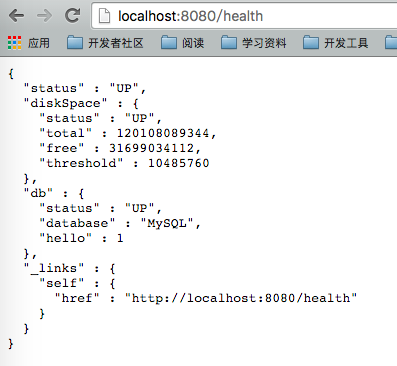
除了/health可以访问,其他的Endpoints也可以访问,例如/info:首先在application.properties文件中添加对应的属性值,符号@包围的属性值来自pom.xml文件中的元素节点。
要获取配置文件中的节点值,需要在pom文件中进行一定的配置,首先在<build>节点里面添加:
然后在<plugins>节点里面增加对应的插件:
然后运行应用程序,访问http://localhost:8080/info,可以看到下列信息
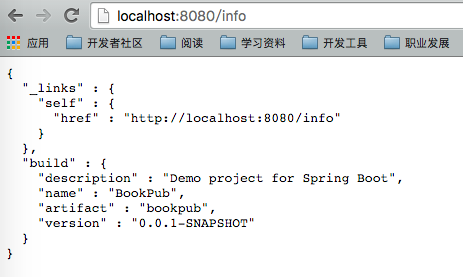
除了使用系统默认的监控信息,我们还可以定义自己的health indicator。使用Spring Boot:定制自己的starter一文中做过的db-count-starter作为观察对象,我们希望监控每个数据库接口的运行状况:如果某个接口返回的个数大于等于0,则表示系统正常,表示为UP状态;否则,可能该接口发生异常,表示为DOWN状态。首先,将DbCountRunner类中的getRepositoryName方法由private转为protected,然后在db-count-starter这个模块中也添加actuator依赖。
在db-count-starter/src/main/com/test/bookpubstarter目录下创建DbCountHealthIndicator.java文件
最后,还需要注册刚刚创建的健康监控器,在DbCountAutoConfiguration.java中增加如下定义:
运行程序,然后访问http://localhost:8080/health,则可以看到如下结果
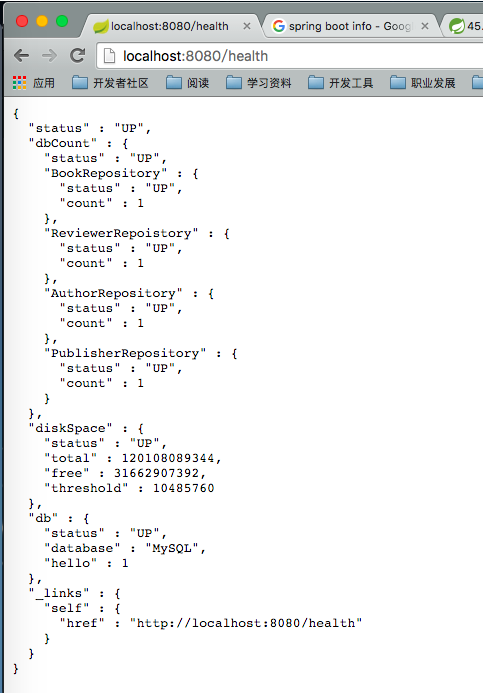
Spring Boot Autuator这个库包括很多自动配置,对外开放了很多endpoints,通过这些endpoints可以访问应用的运行时状态:
这些变量的值由Environment实例中的PropertySource实例保存,根据这些属性值所在的层次,有可能在运行时已经做了值替换,跟配置文件中的不一样了。为了确认某个属性的具体值,例如book.count.rate属性,可以访问http://localhost:8080/env/book.counter.rate来查询,如果跟配置文件中的不一样,则可能是被系统变量或者命令行参数覆盖了。EnvironmentEndpoint类负责实现上述功能,有兴趣可以再看看它的源码;
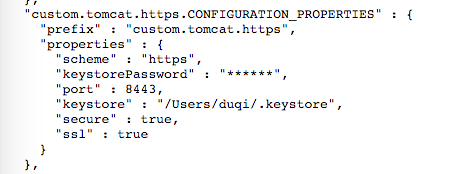
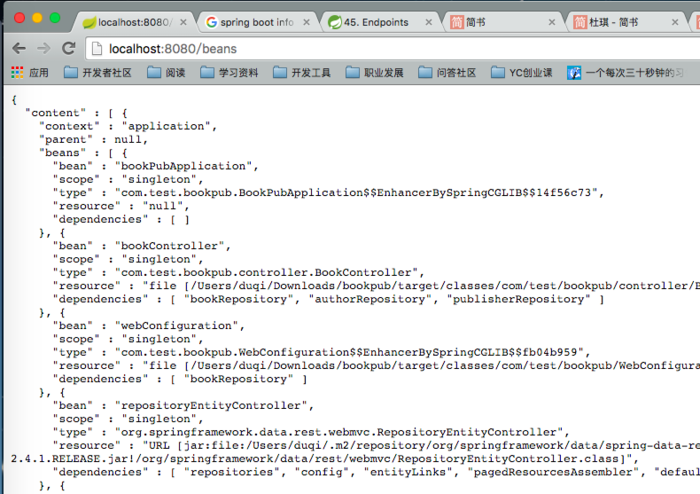
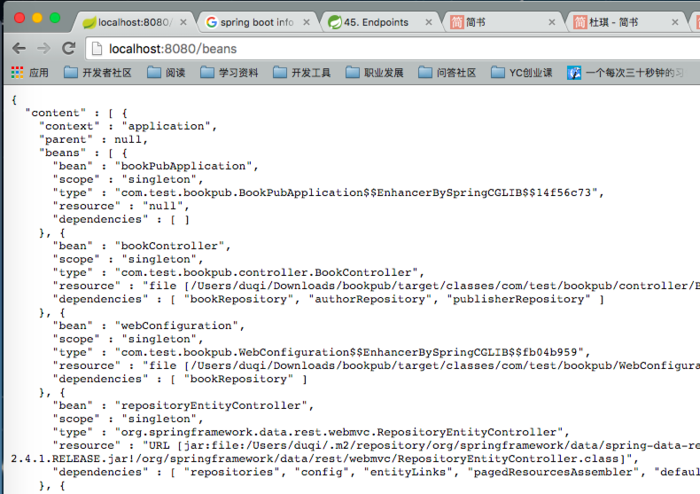
上述各个endpoint是Spring Boot Actuator提供的接口和方法,接下来看看我们自己定制的HealthIndicator,我们只需要实现HealthIndicator接口,Spring Boot会收集该接口的实现,并加入到/health这个endpoint中。
在我们的例子中,我们为每个CrudRepository实例都创建了一个HealthIndicator实例,为此我们创建了一个CompositeHealthIndicator实例,由这个实例管理所有的DbHealthIndicator实例。作为一个composite,它会提供一个内部的层次关系,从而可以返回JSON格式的数据。
代码中的HealthAggregator实例的作用是:它维护一个map,告诉CompositeHealthIndicator如何决定所有HealthIndicator代表的整体的状态。例如,除了一个repository返回DOWN其他的都返回UP,这时候这个composite indicator作为一个整体应该返回UP还是DOWN,HealthAggregator实例的作用就在这里。
Spring Boot使用的默认的HealthAggregator实现是OrderedHealthAggregator,它的策略是手机所有的内部状态,然后选出在DOWN、OUT_OF_SERVICE、UP和UNKNOWN中间具有最低优先级的那个状态。这里使用策略设计模式,因此具体的状态判定策略可以改变和定制,例如我们可以创建定制的HealthAggregator:
最后需要考虑下安全问题,通过这些endpoints暴露出很多应用的信息,当然,Spring Boot也提供了配置项,可以关闭指定的endpoint——在application.properties中配置<name>.enable=false;
还可以通过设置management.port=-1关闭endpoint的HTTP访问接口,或者是设置其他的端口,供内部的admin服务访问;除了控制端口,还可以设置仅仅让本地访问,只需要设置management.address=127.0.0.1;通过设置management.context-path=/admin,可以设置指定的根路径。综合下,经过上述设置,在本地访问http://127.0.0.1/admin/health来访问健康状态。
可以在防火墙上屏蔽掉不是/admin/*的endpoints访问请求,更进一步,利用Spring Security可以配置验证信息,这样要访问当前应用的endpoints必须使用用户名和密码登陆。
<dependency> <groupId>org.springframework.boot</groupId> <artifactId>spring-boot-starter-actuator</artifactId> </dependency>
spring-boot-starter-actuator这个库让我们可以访问应用的很多信息,包括:/env、/info、/metrics、/health等。现在运行程序,然后在浏览器中访问:http://localhost:8080/health,将可以看到下列内容

除了/health可以访问,其他的Endpoints也可以访问,例如/info:首先在application.properties文件中添加对应的属性值,符号@包围的属性值来自pom.xml文件中的元素节点。
info.build.artifact=@project.artifactId@ info.build.name=@project.name@ info.build.description=@project.description@ info.build.version=@project.version@
要获取配置文件中的节点值,需要在pom文件中进行一定的配置,首先在<build>节点里面添加:
<resources> <resource> <directory>src/main/resources</directory> <filtering>true</filtering> </resource> </resources>
然后在<plugins>节点里面增加对应的插件:
<plugin> <groupId>org.apache.maven.plugins</groupId> <artifactId>maven-resources-plugin</artifactId> <version>2.6</version> <configuration> <delimiters> <delimiter>@</delimiter> </delimiters> <useDefaultDelimiters>false</useDefaultDelimiters> </configuration> </plugin>
然后运行应用程序,访问http://localhost:8080/info,可以看到下列信息

除了使用系统默认的监控信息,我们还可以定义自己的health indicator。使用Spring Boot:定制自己的starter一文中做过的db-count-starter作为观察对象,我们希望监控每个数据库接口的运行状况:如果某个接口返回的个数大于等于0,则表示系统正常,表示为UP状态;否则,可能该接口发生异常,表示为DOWN状态。首先,将DbCountRunner类中的getRepositoryName方法由private转为protected,然后在db-count-starter这个模块中也添加actuator依赖。
在db-count-starter/src/main/com/test/bookpubstarter目录下创建DbCountHealthIndicator.java文件
public class DbCountHealthIndicator implements HealthIndicator {
private CrudRepository crudRepository;
public DbCountHealthIndicator(CrudRepository crudRepository) {
this.crudRepository = crudRepository;
}
@Override
public Health health() {
try {
long count = crudRepository.count();
if (count >= 0) {
return Health.up().withDetail("count", count).build();
} else {
return Health.unknown().withDetail("count", count).build();
}
} catch (Exception e) {
return Health.down(e).build();
}
}
}最后,还需要注册刚刚创建的健康监控器,在DbCountAutoConfiguration.java中增加如下定义:
@Autowired
private HealthAggregator healthAggregator;
@Bean
public HealthIndicator dbCountHealthIndicator(Collection<CrudRepository> repositories) {
CompositeHealthIndicator compositeHealthIndicator = new
CompositeHealthIndicator(healthAggregator);
for (CrudRepository repository: repositories) {
String name = DbCountRunner.getRepositoryName(repository.getClass());
compositeHealthIndicator.addHealthIndicator(name, new DbCountHealthIndicator(repository));
}
return compositeHealthIndicator;
}运行程序,然后访问http://localhost:8080/health,则可以看到如下结果

Spring Boot Autuator这个库包括很多自动配置,对外开放了很多endpoints,通过这些endpoints可以访问应用的运行时状态:
env
/env提供应用程序的环境变量,如果你在调试时想知道某个配置项在运行时的值,可以通过这个endpoint访问——访问http://localhost:8080/env,可以看到很多方面的配置,例如,class path resources—[tomcat.https.properties]、applicationConfig—[classpath:/application.properties]、commonsConfig、systemEnvironment、systemProperties等。这些变量的值由Environment实例中的PropertySource实例保存,根据这些属性值所在的层次,有可能在运行时已经做了值替换,跟配置文件中的不一样了。为了确认某个属性的具体值,例如book.count.rate属性,可以访问http://localhost:8080/env/book.counter.rate来查询,如果跟配置文件中的不一样,则可能是被系统变量或者命令行参数覆盖了。EnvironmentEndpoint类负责实现上述功能,有兴趣可以再看看它的源码;
configprops
/configprops提供不同配置对象,例如WebConfiguration.TomcatSslConnectionProperties,它与/env不同的地方在于它会表示出与配置项绑定的对象。尝试下访问http://localhost:8080/configprops,然后在网页中查询custom.tomcat.https,可以看到我们之前用于配置TomcatSslConnector对象的属性值(参见:让你的Spring Boot工程支持HTTP和HTTPS)。
autoconfig
/autoconfig以web形式对外暴露AutoConfiguration 信息,这些信息的解释可以参考Spring Boot:定制自己的starter一文,这样我们就不需要通过“修改应用程序的日志级别和查看应用的启动信息”来查看应用的自动配置情况了。beans
/beans,这个endpoint列出所有由Spring Boot创建的bean。
mapping
/mapping,这个endpoint显示当前应用支持的URL映射,该映射关系由HandlerMapping类维护,通过这个endpoint可以查询某个URL的路由信息。
info
/info,这个endpoint显示应用程序的基本描述,在之前的实践例子中我们看过它的返回信息,属性值来自appliaction.properties,同时也可以使用占位符获取pom.xml文件中的信息。任何以info.开头的属性都会在访问http://localhost:8080/info时显示。health
/health提供应用程序的健康状态,或者是某个核心模块的健康状态。metrics
/metrics,这个endpoint显示Metrics 子系统管理的信息上述各个endpoint是Spring Boot Actuator提供的接口和方法,接下来看看我们自己定制的HealthIndicator,我们只需要实现HealthIndicator接口,Spring Boot会收集该接口的实现,并加入到/health这个endpoint中。
在我们的例子中,我们为每个CrudRepository实例都创建了一个HealthIndicator实例,为此我们创建了一个CompositeHealthIndicator实例,由这个实例管理所有的DbHealthIndicator实例。作为一个composite,它会提供一个内部的层次关系,从而可以返回JSON格式的数据。
代码中的HealthAggregator实例的作用是:它维护一个map,告诉CompositeHealthIndicator如何决定所有HealthIndicator代表的整体的状态。例如,除了一个repository返回DOWN其他的都返回UP,这时候这个composite indicator作为一个整体应该返回UP还是DOWN,HealthAggregator实例的作用就在这里。
Spring Boot使用的默认的HealthAggregator实现是OrderedHealthAggregator,它的策略是手机所有的内部状态,然后选出在DOWN、OUT_OF_SERVICE、UP和UNKNOWN中间具有最低优先级的那个状态。这里使用策略设计模式,因此具体的状态判定策略可以改变和定制,例如我们可以创建定制的HealthAggregator:
最后需要考虑下安全问题,通过这些endpoints暴露出很多应用的信息,当然,Spring Boot也提供了配置项,可以关闭指定的endpoint——在application.properties中配置<name>.enable=false;
还可以通过设置management.port=-1关闭endpoint的HTTP访问接口,或者是设置其他的端口,供内部的admin服务访问;除了控制端口,还可以设置仅仅让本地访问,只需要设置management.address=127.0.0.1;通过设置management.context-path=/admin,可以设置指定的根路径。综合下,经过上述设置,在本地访问http://127.0.0.1/admin/health来访问健康状态。
可以在防火墙上屏蔽掉不是/admin/*的endpoints访问请求,更进一步,利用Spring Security可以配置验证信息,这样要访问当前应用的endpoints必须使用用户名和密码登陆。
相关文章推荐
- 13-Spring Boot (采用actuator监控spring boot的健康 )
- spring boot/cloud 应用监控
- spring-boot 之 使用Admin监控应用
- spring-boot 之 使用Admin监控应用
- Spring Boot 应用可视化监控(Prometheus + Grafana)
- spring-boot 之 使用Admin监控应用
- SpringBoot actuator 应用监控。
- 使用SpringBoot Actuator监控应用
- 使用SpringBoot Actuator监控应用示例
- spring-boot 之 使用Admin监控应用
- spring-boot 之 使用Admin监控应用
- spring-boot使用Admin监控应用的方法
- SpringBoot之旅 -- SpringBoot 项目健康检查与监控
- SpringBoot-Actuator应用监控以及优雅停机
- spring-boot-starter-actuator(健康监控)配置和使用
- SpringBoot应用在CentOS下的监控及服务化脚本实现
- Spring Boot 揭秘与实战(九) 应用监控篇 - HTTP 应用监控
- SpringBoot之旅 -- SpringBoot 项目健康检查与监控
- 使用Spirng Boot Admin监控Spring Cloud应用项目
- SpringBoot实现项目健康检查与监控
